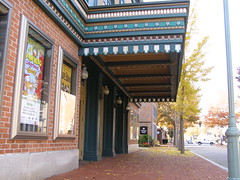| schwartz center (Photo credit: ChrisHConnelly) |
The backdrop for this renewed attention is, of course, the country's dire fiscal outlook and President Obama's proposal to raise taxes to close the gap. As Jeremy Schwartz, director of research at WisdomTree Investments (WETF), points out in the attached video, on January 1 a decade of preferential 15% tax rates is set to end, rising to 20% for capital gains, while dividends would be taxed as ordinary income again.
"Since the President enacted a 0.9% Medicare payroll tax, plus another 3.8% to fund Obamacare," Schwartz says, "the highest tax on dividends is set to go up to 43% under that scenario for the highest income earners."
Conventional wisdom suggests that nearly tripling the top tax rate for dividends would lower after-tax returns, thus reducing the overall demand for dividend-paying stocks. However, Schwartz says there "are number of mitigating factors" that would reduce the actual impact — namely the fact that nearly 50% of dividend-paying stocks are held in s0-called "tax insensitive accounts," such as IRAs, pension funds, endowments and non-profits. He also thinks that any sell-off in these stocks would likely be short-lived, as it "could motivate these investors" to scoop up bargains.
Another area to watch, Schwartz says, is the effect tax policy is having on the companies, which have "already been doing stock buybacks over traditional dividends" at about twice the historical rate. "You now have half the dividends being paid out as usual," he says.
Schwartz adds that another softening effect of the proposed tax increase comes from the fact that only about half the fully-taxed dividend holders are subject to the top rate. To sum it all up, Schwartz is saying that half the dividends are in tax-free accounts and only the remaining half is subject to the tax rate.
He also points out a paradox between tax rates and market performance, pointing out that for the past decade we have had the lowest rate on dividends and gains in 70 years, yet "this past decade was one of the worst for both dividend-paying stocks and the broad market." Inversely, he argues that the last time dividend tax rates were increased (from 31% to 39.6%) was under President Clinton in 1993, "and it was one of the best decades for dividend stocks." Even during the 1940's, when the rate went as high as 90%, he says overall returns were still good.
"The bottom line conclusion of our research is that the market environment is more important than the tax environment," says Schwartz......

No comments:
Post a Comment